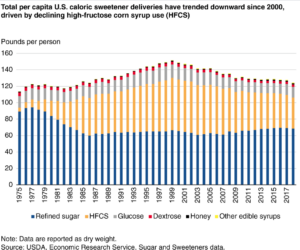I’m on the visionary panel. To register, click here.

I’m still seeing articles coming out from the USDA’s Economic Research Service, now sadly moved to Kansas City. This one is based on an older article.* It’s about how “consumption” of sugars (in quotes because the data actually reflect the availability of sugars in the food supply—production less exports plus imports).

Here’s how I read this chart:
The big reason for the decline is lower consumption of soft drinks (these account for nearly half total sugars consumed).
Another trend is substitution of HFCS by table sugar. This is to the higher cost of HFCS relative to table sugar. It used to be much cheaper but increased demand for corn to produce ethanol has made HFCS and table sugar cost about the same.
Also, HFCS has a reputation for being worse for health than table sugar, but they are about the same physiologically. HFCS is glucose and fructose separated. Table sugar is glucose and fructose stuck together (but quickly separated in the body).
I’m all for eating less of either one. This, at least, is a healthy trend.
*Sugar and Sweeteners Outlook: July 2019 , by Michael McConnell and David W. Olson, ERS, July 2019